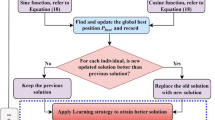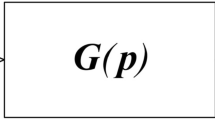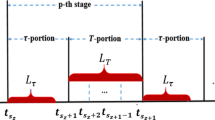Abstract
In this paper, the authors propose a novel model order reduction method integrating evolutionary and conventional approaches for higher-order linear time-invariant single-input–single-output (SISO) and multi-input–multi-output (MIMO) dynamic systems. The proposed method makes use of a differential evolution algorithm with enhanced mutation operation for the determination of reduced order model (ROM) denominator polynomial coefficients. In addition, an improved multi-point Padé approximation method is used to determine the optimal ROM numerator polynomial coefficients. The optimum property of the ROM is measured by minimising the integral square of the step response error between the original high-order dynamic system and the ROM. In the case of the MIMO system reduction approach, an optimal ROM transfer function matrix is determined by minimising a single objective function. This objective function is defined by a linear scalarising of the multi-step error function matrix components \( \left( {E_{ij} } \right) \). The proposed method guarantees the preservation of the stability, passivity and accuracy of the original higher-order system in the ROM. The proposed method is validated by applying it to a ninth-order SISO system, as well as to the tenth- and sixth-order linearised single-machine infinite-bus power system model with and without an automatic excitation control system. The simulation results and the comparison of the integral square error and impulse response energy values of the ROM demonstrate the dominance of the proposed method over the latest reduction methods available in the literature.














Similar content being viewed by others
References
O.M.K. Alsmadi, S.S. Saraireh, Z.S. Abo-Hammour, A.H. Al-Marzouq, Substructure preservation Sylvester-based model order reduction with application to power systems. Electric Power Compon. Syst. 42(9), 914–926 (2014)
P. Boby, J. Pal, An evolutionary computation-based approach for reduced order modelling of linear systems, in IEEE International Conference on Computational Intelligence and Computing research, @Coimbatore, India, 28–29 Dec (2010). https://doi.org/10.1109/iccic.20
A.K. Choudhary, S. Nagar, Order reduction in z-domain for interval system using an arithmetic operator. Circuits Syst. Signal Process. 38(3), 1023–1038 (2019)
S.R. Desai, R. Prasad, A new approach to order reduction using stability equation and big bang big crunch optimization. Syst. Sci. Control Eng. 1(1), 20–27 (2013)
S.R. Desai, R. Prasad, A novel order diminution of LTI systems using big bang big crunch optimization and routh approximation. Appl. Math. Model. 37(16–17), 8016–8028 (2013)
H.K. Fathy, D. Geoff Rideout, L.S. Louca et al., A review of proper modelling techniques. ASME J. Dyn. Syst. Measur. Control 130(6), 061008-1–061008-10 (2008)
R. Genesio, M. Milanese, A note on the derivation and use of reduced order models. IEEE Trans. Automat. Control 21(1), 118–122 (1976)
D.H. George, R. Luss, Model reduction by minimization of integral square error performance indices. J. Franklin Inst. 327(3), 343–357 (1990)
A. Ghafoor, M. Imran, Passivity preserving frequency weighted model order reduction technique. Circuits Syst. Signal Process. 36(11), 4388–4400 (2017)
W.G. Heffron, R.A. Phillips, Effect of modern amplidyne voltage regulators on the under-excited operation of large turbine generators. AIEE Trans. PAS-71, 692–697 (1952)
M. Imran, A. Abdul Ghafoor, A Frequency limited interval gramians-based model reduction technique with error bounds. Circuits Syst. Signal Process. 34(11), 3505–3519 (2015)
M. Javad, M.G. Karolos, Efficient Modeling and Control of Large-Scale Systems (Springer, Newyork, 2010)
D. Karaboga, S. Okdem, A simple and global optimization algorithm for engineering problems: differential evolution algorithms. Turk. J. Electr. Eng. 12(1), 53–60 (2004)
R.J. Lakshmi, P.M. Rao, C. Chakravarthi, A method for the reduction of MIMO system using interlacing property and coefficient matching. Int. J. Comput. Appl. 1(9), 14–17 (2010)
T.N. Lucas, Optimal model reduction by multipoint pade approximation. J. Franklin Inst. 330(1), 79–93 (1993)
T.N. Lucas, Suboptimal model reduction by multi-point pade approximation. Proc. Inst. Mech. Eng. Part I J. Syst. Control Eng. 208(2), 131–134 (1994)
T.N. Lucas, Constrained suboptimal pade model reduction. Proc. Inst. Mech. Eng. Part I J. Syst. Control Eng. 209(1), 30–35 (1995)
S. Mukherjee, R.C. Mittal, Model order reduction using response-matching technique. J. Frankl. Inst. 342(5), 503–519 (2005)
R. Narayan Panda, P. Sasmita kumara, S. Prasad, S. PrasadaPanigrahi, Reduced complexity dynamic systems using approximate control moments. Circuits Syst. Signal Process. 31(5), 1731–1744 (2012)
A. Narwal, R. Prasad, Order reduction of LTI systems and their qualitative comparison. IETE Tech. Rev. 34(16), 655–663 (2017)
H. Nasirisoloklo, R. Hajmohammadi, M.M. Farsangi, Model order reduction based on moment matching using Legendre wavelet and harmony search algorithm. IJST Trans. Electr. Eng. 39(E1), 39–54 (2015)
K. Nicholas, J.M. McCourt, M. Xia, G. Vijay, On relationships among passivity, positive realness, and dissipativity in linear systems. Automatica 50(4), 1003–1016 (2014)
Y.Y. Nie, X.K. Xie, New criteria for polynomial stability. IMA J. Math. Control Inf. 4(1), 1–12 (1987)
G. Pamar, S. Mukherjee, R. Prasad, Reduced order modelling of linear MIMO systems using genetic algorithm. Int. J. Simul Model 6(3), 173–184 (2007)
D.P. Papadopoulos, Order reduction of linear system models with a time-frequency domain method. J. Franklin Inst. 322(4), 209–220 (1986)
U. Salma, K. Vaisakh, Application and comparative analysis of various classical and soft computing techniques for model reduction of MIMO systems. Intell. Ind. Syst. 1(4), 313–330 (2015)
S. Saxena, Y.V. Hote, Load frequency control in power systems via internal model control scheme and model-order reduction. IEEE Trans. Power Syst. 28(3), 2749–2757 (2013)
A. Sharma, H. Sharma, A. Bhargava, N. Sharma, Power law-based local search in spider monkey optimisation for lower order system modelling. Int. J. Syst. Sci. 48(1), 150–160 (2017)
B. Shivanagouda, V.H. Yogesh, Sahaj Saxena, Reduced-order modelling of linear time invariant systems using big bang big crunch optimization and time moment matching method. Appl. Math. Model. 40(15–16), 7225–7244 (2016)
A. Sikander, R. Prasad, Linear time invariant system reduction using mixed method approach. Appl. Math. Model. 39(16), 4848–4858 (2015)
A. Sikander, R. Prasad, Soft computing approach for model order reduction of linear time-invariant systems. Circuits Syst. Signal Process. 34(11), 3471–3487 (2015)
A. Sikander, P. Thakur, Reduced order modelling of linear time-invariant system using modified cuckoo search algorithm. Soft Comput. Methodol. Appl. 22(10), 3449–3459 (2018)
J. Singh, C.B. Vishwakarma, C. Kalyan, Biased reduction method by combining improved modified pole clustering and improved Pade approximations. Appl. Math. Model. 40(2), 1418–1426 (2016)
J. Singh, C. Kalyan, C.B. Vishwakarma, Two degrees of freedom internal model control-PID design for LFC of power systems via logarithmic approximations. ISA Trans. 72, 185–196 (2018). https://doi.org/10.1016/j.isatra.2017.12.002
R. Stron, P. Kennith, Differential evaluation: a simple and efficient adaptive scheme for global optimization over continuous spaces. J. Glob. Optim. 11(4), 341–359 (1997)
G. Vasu, G. Sandeep, K.V.S. Santosh, Reduction of large scale linear dynamic SISO and MIMO systems using differential evolution algorithm, in IEEE Students Conference on Electrical, Electronics and Computer Science (SCEECS-2012) @ Bhopal, India (2012). https://doi.org/10.1109/sceecs.2012.6184732
G. Vasu, M. Sivakumar, M. Ramalingaraju, A novel model order reduction technique for linear continuous-time system using PSO-DV algorithm. J. Control Autom. Electr. Syst. 28(1), 68–77 (2016)
C.B. Vishwakarma, R. Prasad, MIMO system reduction using modified pole clustering and genetic algorithm. Model. Simul. Eng. (2009). https://doi.org/10.1155/2009/540895
Author information
Authors and Affiliations
Corresponding author
Additional information
Publisher's Note
Springer Nature remains neutral with regard to jurisdictional claims in published maps and institutional affiliations.
Appendix
Appendix
The single-machine infinite-bus (SMIB) power system, which is considered in Example 2, is shown in Fig. 15.
The system under study consists of a three-phase, two-pole 160-MVA turbogenerator with an automatic excitation control system (i.e. a standardised IEEE Type-I exciter with rate feedback and power system stabilising signals) supplying power via a step-up transformer and a high voltage transmission line to an infinite grid. In Fig. 15, \( X_{T} \) and \( X_{L} \) represent the reactance of the transformer and the transmission line, respectively, and \( V_{T} \) and \( V_{B} \) are the generator terminal and infinite-bus voltages, respectively.
A detailed block diagram of the SMIB power system [25] is shown in Fig. 16. The numerical values of the parameters that define the total system and its operating point come from [24, 25] and are given below.
The nomenclature of the above system parameters is as follows:
\( \delta , \omega , V_{T} , P, Q \) | \( \begin{aligned} {\text{Synchronous}}\;{\text{machine}}\;{\text{torque}}\;{\text{angle}},\;{\text{Speed}},\;{\text{Terminal }}\;{\text{voltage}},\;{\text{Active}}\; {\text{and }} \hfill \\ \;{\text{Reactive}}\;{\text{power}} \hfill \\ \end{aligned} \) |
\( K_{1} , K_{2} , K_{3} , K_{4} ,K_{5} , K_{6} \) | \( {\text{Synchronous machine linear model parameters}} \) |
\( H, T_{a} , T_{e} , T_{m} \) | \( {\text{Synchronous}}\;{\text{machine }}\;{\text{inertia }}\;{\text{constant}},\;{\text{Accelerating}},\;{\text{Electrical}}\;{\text{and}}\;{\text{Mechanical}}\;{\text{torques}} \) |
\( R_{e} , X_{e} \) | \( {\text{Equivalent}}\;{\text{resistance }}\;{\text{and}}\;{\text{Reactance }}\;{\text{of}}\; {\text{external }}\;{\text{system}} \) |
\( E_{q} , E_{FD} , \tau_{d0} \) | \( \begin{aligned} {\text{Voltage }}\;{\text{proportional}}\; {\text{to}}\; d - {\text{axis}}\;{\text{flux}}\;{\text{linkages}},\;{\text{Field }}\;{\text{voltage}}\;{\text{and}}\;{\text{Open - circuit }} \hfill \\ {\text{time}}\;{\text{constant}} \hfill \\ \end{aligned} \) |
\( K_{E} , S_{E} , \tau_{E} \) | \( {\text{Self-excited}}\;{\text{field }}\;{\text{constant}},\;{\text{Saturation}}\;{\text{function}}\;{\text{and}}\;{\text{Time }}\;{\text{constant}}\;{\text{of}}\;{\text{an}}\;{\text{exciter}} \) |
\( K_{A} , \tau_{A} , V_{R} \) | \( {\text{Regulator }}\;{\text{gain}},\;{\text{Time}}\;{\text{constant}}\;{\text{and}}\;{\text{Output }}\;{\text{voltage}} \) |
\( K_{F} , \tau_{F} \) | \( {\text{Rate }}\;{\text{feedback}}\; {\text{gain}}\; {\text{and}}\; {\text{Time}}\; {\text{constant}} \) |
\( K_{R} , \tau_{R} \) | \( {\text{Transducer }}\;\left( {\text{or}} \right)\;{\text{Filter}}\;{\text{gain}}\;{\text{and}}\;{\text{Time}}\;{\text{constant}} \) |
\( K_{0} ,\tau_{0} , V_{s} \) | \( {\text{Speed}}\;{\text{gain}},\;{\text{Reset }}\;{\text{time-lag}}\;{\text{constant}}\;{\text{and}}\;{\text{Stabiliser}}\;{\text{output}}\;{\text{voltage}} \) |
\( \tau_{1} , \tau_{2} , \tau_{3} , \tau_{4} \) | \( {\text{Lead }}\;{\text{and}}\;{\text{Lag }}\;{\text{time }}\;{\text{constants}}\; \tau \; {\text{of}}\; {\text{the}}\; {\text{power}}\; {\text{system}}\; {\text{stabiliser}} \) |
\( s \) | Laplace operator |
\( \Delta \) | Incremental (step) change of input |
The numerical values of the system parameters and operating point are as follows:
\( {\text{Synchronous }}\;{\text{machine}} \) | \( 3{\text{ - phase}}, 160\; {\text{MVA}},\; {\text{power}}\; {\text{factor}} = 0.894,x_{d} = 1.7, x_{q} = 1.6, x_{d}^{\prime} = 0.254 \;{\text{p}} . {\text{u}} . , \) \( \tau_{d0} = 5.9, H = 5.4\; {\text{s}}, \omega_{R} = 314 \;{\raise0.7ex\hbox{${\text{rad}}$} \!\mathord{\left/ {\vphantom {{\text{rad}} {\text{s}}}}\right.\kern-0pt} \!\lower0.7ex\hbox{${\text{s}}$}} \) |
\( {\text{Type - I}}\; {\text{exciter}} \) | \( K_{A} = 50, K_{E} = - 0.17, S_{E} = 0.95, K_{F} = 0.04, K_{R} = 1,K_{0} = 1, \tau_{A} = 0.05, \) \( \tau_{E} = 0.95, \tau_{F} = 1.0, \tau_{R} = 0.05, \tau_{0} = 10.0, \tau_{1} = \tau_{3} = 0.44, \tau_{2} = \tau_{4} = 0.092\;{\text{s}} \) |
\( {\text{External }}\;{\text{system}} \) | \( R_{e} = 0.02, X_{e} = 0.4 \;{\text{p}} . {\text{u}} .\left( {{\text{on}}\;160 \;{\text{MVA }}\;{\text{base}}} \right) \) |
\( {\text{Operating}} \;{\text{point}} \) | \( P_{o} = 1.0, Q_{o} = 0.5, E_{\text{FDo}} = 2.5128, E_{qo} = 0.9986, V_{to} = 1.0, T_{mo} = 1.0\;{\text{p}} . {\text{u}} . , \) \( \begin{aligned} \delta_{o} = 1.1966\; {\text{rad}}, K_{1} = 1.133, K_{2} = 1.3295, K_{3} = 0.3072, K_{4} = 1.8235, \hfill \\ K_{5} = - 0.0433, K_{6} = 0.4777. \hfill \\ \end{aligned} \) |
The system in Fig. 16 can be described in state-space form, as in Eq. (1). The state vector \( X\left( t \right) \) is defined with state variables as \( X^{\text{T}} \left( t \right) = \left[ {E_{q} \omega \delta v_{1} v_{R} E_{FD} v_{2} v_{3} v_{4} v_{5} } \right] \). The input and output vectors are given by \( U^{\text{T}} \left( t \right) = \left[ {\Delta V_{\text{ref}} \Delta T_{m} } \right] \;{\text{and}}\; Y^{\text{T}} \left( t \right) = \left[ {\delta V_{t} } \right] \). For the system parameters and operating points described, the numerical values of the system, input, output and feedforward matrices \( A, B, C \;{\text{and}}\; D \), respectively, are given below.
The system, input and output matrices of the SMIB without AECS (i.e. a standard IEEE Type-I exciter without rate feedback (RF) and without power system stabiliser (PSS)) are represented by \( A^{\prime}, B^{\prime}\;{\text{and}}\; C^{\prime} \), respectively. The state-space representation of the SMIB system without AECS yields a sixth-order model of the following form:
The state vector \( \tilde{X}\left( t \right) \) is defined with state variables as \( \tilde{X}^{\text{T}} \left( t \right) = \left[ {\tilde{E}_{q} \tilde{\omega } \tilde{\delta } \tilde{v}_{1} \tilde{v}_{R} \tilde{E}_{\text{FD}} } \right] \).The input and output vectors are given by \( U^{\text{T}} \left( t \right) = \left[ {\Delta V_{\text{ref}} \Delta T_{m} } \right]\; {\text{and}}\; Y^{\text{T}} \left( t \right) = \left[ {\tilde{\delta } \tilde{V}_{t} } \right] \), respectively.

Rights and permissions
About this article
Cite this article
Vasu, G., Sivakumar, M. & Ramalingaraju, M. Optimal Model Approximation of Linear Time-Invariant Systems Using the Enhanced DE Algorithm and Improved MPPA Method. Circuits Syst Signal Process 39, 2376–2411 (2020). https://doi.org/10.1007/s00034-019-01259-y
Received:
Revised:
Accepted:
Published:
Issue Date:
DOI: https://doi.org/10.1007/s00034-019-01259-y






